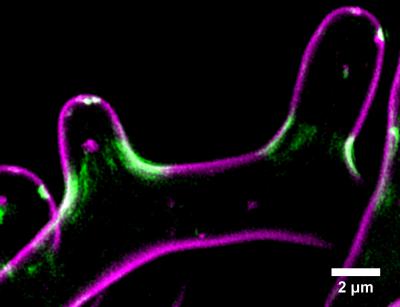A cell senses its own curves: New research from the MBL Whitman Center

This image shows the filamentous fungus Ashbya gossypii. The plasma membrane is visualized in magenta (FM-464), and the septin Cdc11a-GFP is in green. Credit: Andrew Bridges
“Cells adopt diverse shapes that are related to how they function. We wondered if cells have the ability to perceive their own shapes, specifically, the curvature of the [cell] membrane,” says Drew Bridges, a Ph.D. candidate in the laboratory of Amy Gladfelter, associate professor of biological sciences at Dartmouth College and a scientist in the MBL's Whitman Center.
The team focused on the septins, proteins that are usually found near micron-scaled curves in the cell membrane, such as the furrow that marks where the cell will pinch together and divide.
Using live-cell imaging at the MBL, they noticed that septins in a novel model system, the fungus Ashbya gossypii, tended to congregate on fungus branches where curvature was highest.
They then decided to recreate this natural phenomenon in the lab, using artificial materials they could measure more easily than living cells. Using precisely scaled glass beads coated with lipid membranes, they discovered that septin proteins preferred curves in the 1-3 micron range.
They got the same result using human or fungal septins, suggesting that this phenomenon is evolutionarily conserved.
“This ability of septins to sense micron-scaled cell curvature provides cells with a previously unknown mechanism for organizing themselves,” Bridges says.
The idea for the glass bead experiment came from “many rich intellectual discussions with other members of the MBL community,” says Bridges, who has accompanied Gladfelter to the MBL each summer since 2012. “Both our collaborations and the imaging resources at MBL were central to this work.”
###
Citation:
Bridges, A. A., Jentzsch, M.S., Oakes, P.W., Occhipinti, P., and Gladfelter, A.S. (2016) Micron-scale plasma membrane curvature is recognized by the septin cytoskeleton. J Cell Biol 213:23-32, doi:10.1083/jcb.201512029.
The Marine Biological Laboratory (MBL) is dedicated to scientific discovery – exploring fundamental biology, understanding marine biodiversity and the environment, and informing the human condition through research and education. Founded in Woods Hole, Massachusetts in 1888, the MBL is a private, nonprofit institution and an affiliate of the University of Chicago.
Media Contact
All latest news from the category: Life Sciences and Chemistry
Articles and reports from the Life Sciences and chemistry area deal with applied and basic research into modern biology, chemistry and human medicine.
Valuable information can be found on a range of life sciences fields including bacteriology, biochemistry, bionics, bioinformatics, biophysics, biotechnology, genetics, geobotany, human biology, marine biology, microbiology, molecular biology, cellular biology, zoology, bioinorganic chemistry, microchemistry and environmental chemistry.
Newest articles

Sea slugs inspire highly stretchable biomedical sensor
USC Viterbi School of Engineering researcher Hangbo Zhao presents findings on highly stretchable and customizable microneedles for application in fields including neuroscience, tissue engineering, and wearable bioelectronics. The revolution in…

Twisting and binding matter waves with photons in a cavity
Precisely measuring the energy states of individual atoms has been a historical challenge for physicists due to atomic recoil. When an atom interacts with a photon, the atom “recoils” in…

Nanotubes, nanoparticles, and antibodies detect tiny amounts of fentanyl
New sensor is six orders of magnitude more sensitive than the next best thing. A research team at Pitt led by Alexander Star, a chemistry professor in the Kenneth P. Dietrich…





















